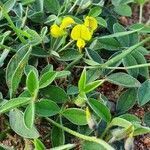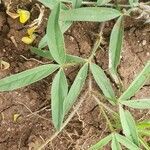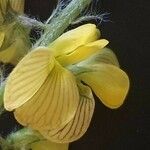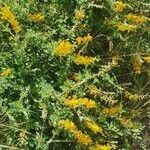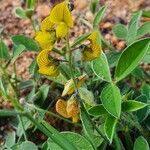Perennial with a thick woody rootstock and a number of curved-ascending or decumbent stems, sometimes up to 30 cm tall, often less; stems pubescent with short appressed or spreading hairs.
Racemes up to 4–10 cm long, pedunculate, with 8–20 flowers rather closely arranged above; bracts 1.5–3 mm long, subulate; bracteoles at the base of the calyx, less than 1 mm long.
Standard obovate-circular to oblate, yellow, veined reddish-brown or purple; wings exceeding the keel; keel 5–6(7) mm long, rounded, with a short blunt beak.
Leaves 3-foliolate, estipulate; leaflets mostly 1.5–4 × 0.6–1.8 cm, elliptic to obovate, appressed puberulous beneath; petiole shorter than the leaflets.
Calyx 3.5–4.5 mm long, basally truncate and deflexed against the pedicel, puberulous; lobes triangular, slightly acuminate, ± as long as the tube.
Pod practically sessile, 15–18 × 4–6 mm, subcylindrical, appressed puberulous, 10–16-seeded.
Seeds 2.5–3 mm long, oblique-cordiform, smooth, dark brown.
